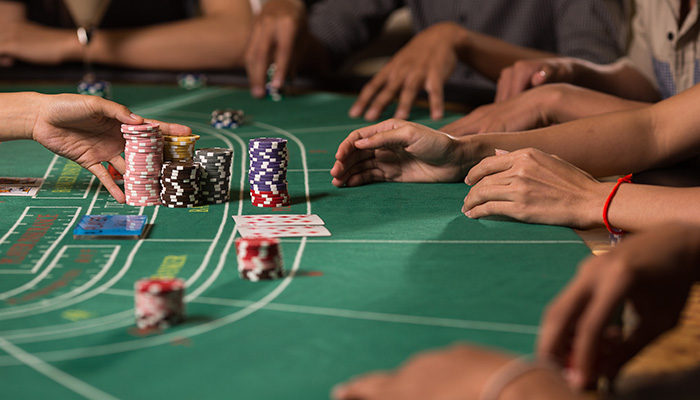Everything You Need to Know About the History of Baccarat
 The History of Baccarat
The History of Baccarat
- Baccarat History: A Rich Past
- Baccarat Origin: 15th Century France?
- How to Play Baccarat: A Beginner’s Guide
- Variants of Baccarat: Punto Banco, Chemin de Fer
- Baccarat’s House Edge and Odds
- Baccarat Side Bets
- Frequently Asked Questions
Baccarat is one of the most iconic casino games in the world, loved by high rollers and casual players alike. Baccarat history stretches back centuries, believed to have first originated in 15th century France, before spreading across Europe and eventually to the rest of the world.
Today, baccarat brings up images of luxury and extravagance, thanks in large part to its prominence in James Bond films and its popularity among high rollers. In this blog post, we’ll explore the fascinating history of baccarat, how to play this casino classic, and look at some popular variations of the game.
Baccarat History: A Rich Past
Baccarat origin is disputed, and, as with many things in life, it ultimately comes down to opinion; historians disagree on the game’s exact origins. However, the vast majority believe it evolved from older card games in 15th century France. As the game grew in popularity and spread to new countries, a number of new variants like Punto Banco, Chemin de Fer, and Baccarat Banque emerged.
Today, baccarat is widely available; you’ll find it offered in virtually every land-based casino and online casino. If you want to play baccarat online, make sure to check out the best online baccarat sites here.
Baccarat Origin: 15th Century France?
According to most gambling historians, baccarat is believed to have first emerged in France in the late 15th century, although pinpointing the game’s exact date of creation is impossible. Some believe it evolved from the ancient Roman ritual of “casting lots”, while others think it originated from older card games like Macao, Ombre, or Tarot.
Historians have traced the first discussion of baccarat back to 1847. A man called Charles Van-Tenac published a short mathematical breakdown of the game – with the goal of helping players improve their chances of winning.
The game rose to fame in the late 15th century when it was introduced to French nobility. The sophisticated nature of the game – and the lack of skill required to play it – made it popular among aristocrats who favored games based purely on chance. King Louis XV was rumored to be a dedicated baccarat player, helping cement its reputation as the blue blood game of nobles and royalty. As the game spread across Europe over centuries, casinos began offering baccarat to attract wealthier clients, and to this day, it’s a casino game associated with the wealthy!
In terms of the game’s modern-day history, it was made famous thanks to the James Bond franchise of movies. Alongside this, high profile celebrity players like Frank Sinatra were often seen playing the game, and before long, luxurious baccarat rooms appeared at many land-based casinos in the US – some even going as far as hiring special marketing firms to make the game appeal almost exclusively to VIPs.
However, once land-based casinos became more common across the US, baccarat started to be available to everyone; table limits were lowered to make it accessible to anyone, and, of course, the rise of online casinos brought the game to pretty much anyone in the world.
Today, you’ll find baccarat at virtually every online casino, and it’s available in multiple variations – some of which we’ll be looking at today. If you want to play baccarat online, make sure to check out our curated list of the best real money online casinos, as all of these sites have been hand-picked by our team of online gambling experts.
How to Play Baccarat: A Beginner’s Guide
Baccarat is one of the easiest casino table games to learn, and the history of the card game baccarat mentions, many times, how its popularity grew thanks to the game’s simplicity. The main objective is to guess which of two hands – the Player and the Banker – will end up having a numerical total closest to nine.
Before the game begins, players are given the chance to place one of three bets: Banker, Player, or Tie. The dealer then deals two 2-card hands face up, one to the player, and one to themselves. The values of the cards are then considered; tens and all face cards are worth 0, aces are worth one, and all other cards are worth their face value. Hand values do not take into account anything over ten, instead only taking the last digit of the number; for example, a hand total of 18 would actually be eight.
If either Player or Banker is dealt an 8 or 9 (called a “natural”), that hand wins. If both hands make naturals, it’s a tie. If neither hand is natural, gameplay goes to whichever hand is closest to 9 based on drawing a third card according to set rules.
Variants of Baccarat: Punto Banco, Chemin de Fer
While the basic goal of baccarat is to get a hand total as close to nine as possible, several variants of the game exist that tweak the rules and gameplay format. The three main versions played today are Punto Banco, Chemin de Fer, and Baccarat Banque.
Punto Banco, popular in America and across Cuba, is the version most commonly found in casinos. Players bet on either “Punto” (Player) or “Banco” (Banker) as the dealer deals out two hands from a six or eight-deck shoe. It has fixed rules and there is no skill element involved; all actions are carried out following predetermined rules. When it comes to baccarat variations, Punto Banco is, by far, the most popular and widespread.
Look deeper into baccarat history and you’ll also see Chemin de Fer mentioned quite a lot. It’s a classic version of the game that first came from France, and even today, it’s still played in many European casinos. Unlike Punto Banco and regular baccarat, Chemin de Fer has a tiny skill element involved, with players taking turns being the Banker. Being the Banker gives players a small advantage, as they get to go last and have the potential of winning larger amounts of money. Each player gets the chance to play the Banker position, with the game rotating around on each new deal.
Another popular baccarat variation is Baccarat Banque. It’s pretty similar to Chemin de Fer, with one key difference: it allows players to bet on two hands instead of one. Each round sees two hands dealt, with players able to bet on either the Player or Banker for both hands. However, unlike Chemin de Fer, the banker role doesn’t rotate; one player is designated as the banker, and in a casino, this will be the house.
Regardless of which baccarat variation you play, the core goal remains the same: you want to form a hand totaling as close to nine as possible. However, the addition of baccarat variations adds something new into the mix, and makes what can be described as a sometimes boring game more exciting.
Baccarat’s House Edge and Odds
Baccarat is famed for boasting one of the lowest house edges out of any casino game; in fact, pretty much only craps and some versions of blackjack are able to offer lower house edges. However, when you’re playing baccarat, the actual house edge you get depends on one main factor; whether you bet on the Player or Banker.
If you play on the Banker bet, the statistical house edge on most games is 1.01%. If you play the Player bet, the average house edge is 1.25%. This compares favorably to most casino games, especially when considering that video slots have a typical house edge of around 6%.
The tie bet significantly favors the house, with a huge house edge of 14.36%! Take into account that ties only happen 9.52% of the time and you can see why this is known as the “sucker’s bet” in baccarat.
Below, we are going to take a look at the three bet types we’ve mentioned – along with two common side bets. We will give you a brief description of each bet, show you the average payout (some casinos will offer slightly different payouts), and look at the house edge versus the true winning odds.
| Bet | Payout | Odds | House Edge | Description |
|---|---|---|---|---|
| Player | 1:1 | 44.62% | 1.24% | A bet on the player’s hand winning. If successful, it pays even money. |
| Banker | 0.95:1 (5% commission) | 45.86% | 1.06% | A bet on the banker’s hand winning. Pays less due to the commission. |
| Tie | 9:1 | 9.52% | 14.36% | A bet on both the player’s and banker’s hands tying. High payout but low winning odds. |
| Player Pair | 11:1 | 7.47% | 10.36% | A bet that the first two cards dealt to the player will be a pair. |
| Banker Pair | 11:1 | 7.47% | 10.36% | A bet that the first two cards dealt to the banker will be a pair. |
Baccarat Side Bets
Baccarat’s simplicity and low house edge make it popular, but there’s no denying that some players find the game boring, especially when you consider there’s only three standard betting options. That’s where side bets come in; they provide additional betting opportunities to spice up gameplay. While the core bets – player, banker, and tie – remain the same, baccarat games with side bets offer increased win potential and excitement.
One of the most popular baccarat side bets is the Dragon Bonus, which pays when your chosen hand wins by a natural or certain margin. Payouts can reach up to 30:1 with this bet. There’s also the Perfect Pair Bet, where you bet on either the player or banker being dealt a pair. Payouts are 5:1 for mixed pairs and 22:1 for identical pairs of the same suit.
Another popular side bet you’ll see offered on many baccarat tables is the Big/Small bet. Here, you bet on whether the total cards dealt will be over or under 13. If you guess correctly, you will be paid out at 1:1 – even money.
While these side bets seem exciting – and often boast significant win potential – it’s important to remember that the house edge is significantly higher than the Player and Banker baccarat bets. Generally, you should see them more as a novelty than a serious betting option.




